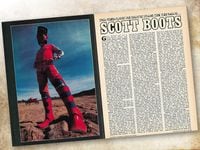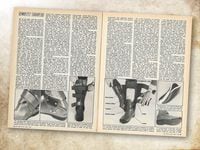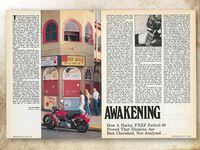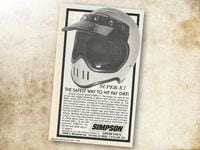Steel-tough Plastic and Galactic Styling Come Together as...Scott Boots
Three and a half years of research from [then] 20-year-old firm Scott that is known for bringing plastic boots to skiing has resulted in a game changer for motorcycle riders. Working with a team of pro riders we can all remember including such legends as Bob Hannah, Scott Blackwell, Danny LaPorte and others the Scott team was on-track to building the boot of the future. By future, we mean Moonraker meets Star Wars. At the time of the writing of the original article Scoot had 18 prototypes invested into this project and back orders from motorcycle dealerships for a boot that was not done yet.
Most boots were built primarily with leather in the ‘70s that became heavier when wet (increased fatigue) and softer (reduced protection) as they aged. Scott who was already building boots for the skier with space age plastics and stainless steel saw an opportunity to revolutionize the riding boot marketplace. They assembled a team of pro riders and got to work.
Early prototypes were rather low tech and did not include the booty that would increase comfort and water protection that later models had. Most of the pro riders would test the boots but few committed to wearing them in competition until young upstart Bob "Hurricane"Hannah wore his at the 1977 Supercross season opener - and fell off. Bob walked away from the mishap with confidence in the product and kept wearing them in practice and during competition. Shortly afterwards, Danny LaPorte followed suit.
Countless designs tweaks and 15 prototypes later, the boot is ready for the market. The street price is $180 which in 1979 dollars was pretty steep. The boot included an inner booty and had two shell sizes. The Scott boot was touted by the Motorcyclist team as an advance in boot design - once you got over the acclimation period. Since Scott took the expensive leap into plastic boot design (around $330,000 in just the final mold plus R&D) it has become the standard for off-highway boot design. If this hadn't of worked out, I'm sure there would have been plenty of Sci Fi movies these early boots could have been featured….
How a Harley FXEF Fat Bob 80 Proved That Illusions Are Best Cherished, Not Analyzed…
Like no other, the Harley experience is wrapped up in the mystique of the machine. It sounds fantastic, it looks the part slung down low and the 1979 Harley-Davidson FXFE Fat Bob with the 80 inch engine is no exception. The author of this article came up like most riders in the '60s and '70s on a lightweight Japanese machine. Bohon then found a special place in his heart for British machinery but always wondered what it was like to ride a Harley.
The opportunity has arrived and it may not have lived up to the writer's expectations but did leave a positive experience in its wake.
- Front brake - non-existent at first, wore in to be marginally acceptable
- Back brake - makes up for the shortcomings of the front.
- Air cleaner - obstructs right leg which makes it hard to reach the brake pedal in traffic
- Vibes - strong up to 2,000 RPMs and all but disappear at 4,000 (80 mph)
- Head-turner - Everyone longingly looks as you pass
“The Fat Bob is not a bad motorcycle. But you have to think about it when you ride, have to compensate for its failings. And you have to be very good to get it to perform.”
When you step back and take a look at the purpose of the FXEF it is obvious that this is meant to be a cruisin’ for burgers, a jammer, a profiler. Once you wrap you head around that it is a joy to ride. The Fat Bob gets a lot of attention you’ll never see on a Universal Japanese Machine (UJM) and will take you across the country comfortably. If that is what you want, the Fat Bob is worth every penny.
Form Follows Function But Cruisin’ For Burgers Is Fun…
In 1979 a bike that fell into the “Specials” Category would be a Kawasaki LTD, Yamaha Special, Honda Custom, or a Suzuki L.
What are the components of a “Special”?
- Gas Tanks - Mounted right up on top of the frame. They are narrow and taper to the seat and don't hold a lot of fuel. Most riders don't mind an excuse to get off of the bike every hour or so anyway..
- Handlebars - Not exactly performance inspiring with their high rolling, drooping down look. They offer bad leverage and weight position that are hard to steer in aggressive riding situations.
- Stepped Seats - Forces the rider into one position. One of being in the motorcycle. At first this feels good but any long distance touring will take a toll. The question is, is the bike really for the long distance rider? Do most riders who even consider themselves long distance riders travel great distances more than once or twice a year? Probably not.
- Forks - Long chrome lines attempting to give a an extended front end (custom) look. The subtraction of rubber gaiters and addition of scrapers help the make these machines look longer but in fact, they are not.
- Small Rear Wheel & Fat [by 1979 standards] Tire - If the guys of 1979 Motorcyclist could see the bikes of today, boy would they have a different opinion.
- Short Mufflers - Disgusting! O or so they said then. Not loud though. In combination with the tank and tires, they really do work quite well together.
“The LimitedCustomSpecials are functional. It is true that they are not “custom”. They are simply styling alternatives. They look like what many buyers want a motorcycle to look like. They function well beyond the capabilities of all but a tiny percentage of riders. And those riders tailor their bikes to themselves anyway.”
The truth is, they look good and make the riders who buy them happy. Hooray!










/cloudfront-us-east-1.images.arcpublishing.com/octane/AHBRTXRNS43A6YXNVPQNGT2QSY.jpg)





/cloudfront-us-east-1.images.arcpublishing.com/octane/GTCXACQGJ5HAPDTGWUQKDEH44E.jpg)
/cloudfront-us-east-1.images.arcpublishing.com/octane/S35YGSEMEZB4BLTDJTSZPF4GLA.jpg)
/cloudfront-us-east-1.images.arcpublishing.com/octane/5UOT6HPX2JFMRJAX6EH45AR4MQ.jpg)
/cloudfront-us-east-1.images.arcpublishing.com/octane/OKWOJWAKP5EP3OACCRRWPCIX2Q.jpg)
/cloudfront-us-east-1.images.arcpublishing.com/octane/2WF3SCE3NFBQXLDNJM7KMXA45E.jpg)
/cloudfront-us-east-1.images.arcpublishing.com/octane/G4MG6OUCJNBSHIS2MVVOTPX65E.jpg)
/cloudfront-us-east-1.images.arcpublishing.com/octane/IIGGWFOTOJGB7DB6DGBXCCMTDY.jpg)
/cloudfront-us-east-1.images.arcpublishing.com/octane/QSTCM6AVEZA5JJBUXNIQ3DSOF4.jpg)
/cloudfront-us-east-1.images.arcpublishing.com/octane/U4I7G625B5DMLF2DVIJDFZVV6M.jpg)
/cloudfront-us-east-1.images.arcpublishing.com/octane/B6XD6LS6IVCQPIU6HXDJSM3FHY.jpg)
/cloudfront-us-east-1.images.arcpublishing.com/octane/ICL63FEDDRDTTMINYICCEYGMDA.jpg)
/cloudfront-us-east-1.images.arcpublishing.com/octane/FCGZHQXRBZFLBAPC5SDIQLVF4I.jpg)
/cloudfront-us-east-1.images.arcpublishing.com/octane/WNOB6LDOIFFHJKPSVIWDYUGOPM.jpg)

/cloudfront-us-east-1.images.arcpublishing.com/octane/X33NU3E525ECRHXLNUJN2FTRKI.jpg)
/cloudfront-us-east-1.images.arcpublishing.com/octane/6KKT5NNL2JAVBOXMZYS5ZO76YA.jpg)
/cloudfront-us-east-1.images.arcpublishing.com/octane/J5RKG5O455GMPGQRF2OG6LRT7A.jpg)
/cloudfront-us-east-1.images.arcpublishing.com/octane/GX2CIZKQVRH2TATDM26KFG2DAE.jpg)
/cloudfront-us-east-1.images.arcpublishing.com/octane/ZWIDYSAKQZHD5BHREMQILXJCGM.jpg)
/cloudfront-us-east-1.images.arcpublishing.com/octane/CYUHJZCTSJCH3MRAQEIKXK7SCQ.jpg)
/cloudfront-us-east-1.images.arcpublishing.com/octane/LKOFINY56FCXJCANJ5M7ZDQUBY.jpg)
/cloudfront-us-east-1.images.arcpublishing.com/octane/4NBPDACMWJH63JQYJVK3QRBDZI.jpg)
/cloudfront-us-east-1.images.arcpublishing.com/octane/KKHQHRR3FJGX7H2IPU6RALMWG4.jpg)
